Born and raised in the United States with clean, inexpensive running water everywhere I lived, I never imagined there would come a day of water crises. I realize now that eventually water will be more valuable than oil. This reality should prompt homeowners with water wells to invest in their own manual water supply system.
The vast technology and knowledge acquired during the past century helped humanity immensely. Some technology even forecasts many potential hazards, such as greater natural disasters from climate change.
With this advanced technology also comes even greater threats, such as cyberterrorism, nuclear war, nuclear disaster, and even an electro-magnetic pulse attack that could leave the U.S. in a technological world equivalent to the 1800s. Ultimately, a decline of fresh water threatens the population and causes worldwide water wars. Water conflicts have already begun in the United States and Middle East.
Before electricity, civilizations and empires were built by human ingenuity and power. Various massive water-lifting machines were constructed to supply enough water. Today, modern societies worldwide depend on electricity to power water pumps for their needs. Natural disasters, or an EMP and other threats can render the power grid useless, leaving masses without fresh water needed for survival.
Alternative energy
With the power grid down, fresh water shortages won’t be the only crisis. Disruptions in the supply chain will create food, fuel and other shortages causing civil unrest. No commodities necessary for the stability of our modern life will be delivered as before. Because of these threats and a host of others, countless people are preparing for what is most vital – food, water and shelter.
Many landowners with a private water well are storing all types of food and learning how to grow their own for survival. Some are prepping with modern technology equipment, investing in large generators and fuel storage tanks so they can still flip on the lights and run electric appliances and water pumps needed for the home, livestock and gardens. Others are investing in micro-grid systems known as alternative energy – solar and wind power to operate their solar pumps and homes. Ironically, some of the same threats can render both systems useless, leaving them without the fresh water supply as before – leaving the homestead equivalent to the 1800s.
“Water is the driving force of all nature.” – Leonardo da Vinci
Water should be the first preparation for survival. Without it, crops won’t grow, livestock will die and all prepping efforts will be for nothing, no matter how much money is expended. City dwellers will have the hardest time finding potable water for survival. On average, humans can only live three days without water. Think ahead and prepare with a friend or relative who has a water well. Contribute by buying and storing a well bucket for emergencies. You will be glad you did.
How does one plan for an electric well pump failure for any reason during a grid-down situation with a disruption in the supply chain? This depends on how much water is needed daily, the static water level of the well, how many people live on the property – small family, large family or community. It also depends on how large the growing areas are, annual rainfall, how many animals there are, what kind and if there is a dependable year-round water source on the property such as ponds, creeks or springs or just a well. Only the homeowner can truly determine how much water will be needed daily throughout the seasons.
Alternative Water Devices
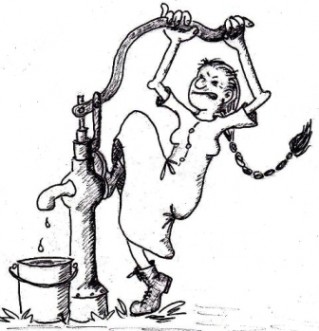 Ram pumps can be set up if there is enough flow of water from a creek or river. A windmill can be set up to supply water only if there is enough wind for operation. Other options are human-powered machines for pumping water, rain catchments, cisterns, hand pumps and well buckets. Think ahead, plan ahead and have as many water devices as reasonably possible. Your life, family, friends, gardens, and animals may depend on it.
Ram pumps can be set up if there is enough flow of water from a creek or river. A windmill can be set up to supply water only if there is enough wind for operation. Other options are human-powered machines for pumping water, rain catchments, cisterns, hand pumps and well buckets. Think ahead, plan ahead and have as many water devices as reasonably possible. Your life, family, friends, gardens, and animals may depend on it.
Getting the water you need from a traditional hand pump is challenging and should be your main concern and shouldn’t be taken lightly. A lot of time can be spent pumping for so little water and may not be practical except for drinking, cooking and light bathing. If you have water sources for other needs, you might be fine with a traditional hand pump, but it won’t hurt to find out. If you already have a hand pump, you should calculate your daily water needs and hand pump daily for a week to see if you can live with it. If you don’t have a hand pump, you might have a friend or family member who does and should practice with it.
If your property does not contain other water sources and your hand pump is not adequate for all your water needs during a long-term SHTF situation, you should consider a human-powered machine capable of pumping high volumes of water from wells. Human-powered machines served humanity well before the age of technology.
There are many different types of hand water pumps on the market to choose from. Some can be used with existing electric well pumps if the cylinders are small enough (yielding less water) to fit in the casing with the existing pump. The majority of these pumps are installed for an emergency backup and are not practical for a long-term emergency. Some can also pressurize the tank for indoor plumbing; but, it takes a lot of time and effort to pressurize an empty 40-gallon tank to 50 psi with such a small cylinder.
Take all the claims of capacity, gallons per minute, and ease of operation of manual well pumps with a grain of salt ― unless they have an actual demonstration of a deep-well application stating the static water level, size of cylinder, length of stroke, age and fitness of operator. You can do the math from there.
Something to consider
If affordable, consider a second well without an electric pump and invest in a quality non-electric water supply system to meet your water needs. In addition, a good-quality well bucket is an ultimate backup. With a bucket, fresh water is always accessible.
Hand pump considerations
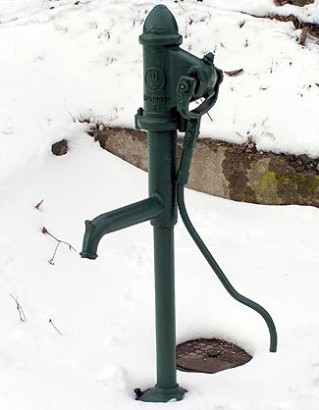 When considering a sucker rod hand pump for long-term and heavy use, use metal rigid pipe, not PVC, for the drop pipe. PVC is too lightweight for a sucker rod pump system. When pumping the handle, the cylinder will lift first before the piston begins to move up within the cylinder, causing the drop pipe to compress between the cylinder and wellhead. This causes the PVC pipe to flex and spiral up within the well casing creating friction between the sucker rod and the inside walls of the drop pipe which reduces the efficiency of the stroke. Eventually, a pipe in the middle of the drop pipe string will crack at a coupling, causing the pump to lose its prime. Metal rigid pipe is much heavier and stronger, maintaining a straighter line between the wellhead and cylinder. Rigid pipe is more expensive; but, consider the value of fresh water.
When considering a sucker rod hand pump for long-term and heavy use, use metal rigid pipe, not PVC, for the drop pipe. PVC is too lightweight for a sucker rod pump system. When pumping the handle, the cylinder will lift first before the piston begins to move up within the cylinder, causing the drop pipe to compress between the cylinder and wellhead. This causes the PVC pipe to flex and spiral up within the well casing creating friction between the sucker rod and the inside walls of the drop pipe which reduces the efficiency of the stroke. Eventually, a pipe in the middle of the drop pipe string will crack at a coupling, causing the pump to lose its prime. Metal rigid pipe is much heavier and stronger, maintaining a straighter line between the wellhead and cylinder. Rigid pipe is more expensive; but, consider the value of fresh water.
Prepare for hand pump failure. Pumps eventually need maintenance and repairs. Buy extra maintenance supplies and necessary spare parts. Build a strong structure around the wellhead for protection and comfortable use. Insulate the enclosure if needed.
An incredible human-powered machine
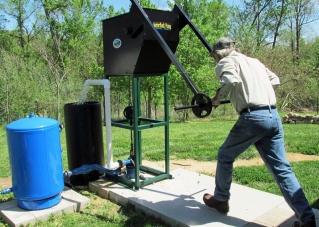 If you cannot find the volume of water needed on your property and with the traditional style hand pumps, you should consider a WaterBuck Pump. It’s unlike any conventional well hand pump known to date. The WaterBuck Pump (aptly named for a water-loving African antelope) has the ability, power and capacity of electric water pumps – pressurizing a tank for indoor plumbing and fire extinguishing. Amazingly, it can be customized with two pump levers and twin cylinders for the ability of 2 operators yielding as much as 188 gallons (27 cycles) a minute at peak performance from a shallow well, if needed for communities, irrigation and fire. Although, there’s room for 4 operators for easier and continuous operation. No other hand water pump has this capability.
If you cannot find the volume of water needed on your property and with the traditional style hand pumps, you should consider a WaterBuck Pump. It’s unlike any conventional well hand pump known to date. The WaterBuck Pump (aptly named for a water-loving African antelope) has the ability, power and capacity of electric water pumps – pressurizing a tank for indoor plumbing and fire extinguishing. Amazingly, it can be customized with two pump levers and twin cylinders for the ability of 2 operators yielding as much as 188 gallons (27 cycles) a minute at peak performance from a shallow well, if needed for communities, irrigation and fire. Although, there’s room for 4 operators for easier and continuous operation. No other hand water pump has this capability.
The WaterBuck pump operates the same windmill pump cylinders successfully used by the windmill industry with cylinders sizes from 1 3/8” to 8” – with up to 3.48 gallons per stroke. For deeper well applications, it can also be equipped with two pump levers and twin cylinders that are designed for the ability of two operators per cylinder, yielding four times the capacity of one operator at any depth within the limits of the WaterBuck. We anticipate reaching static depths more than 700’.
Exceeding Windmill Capacities
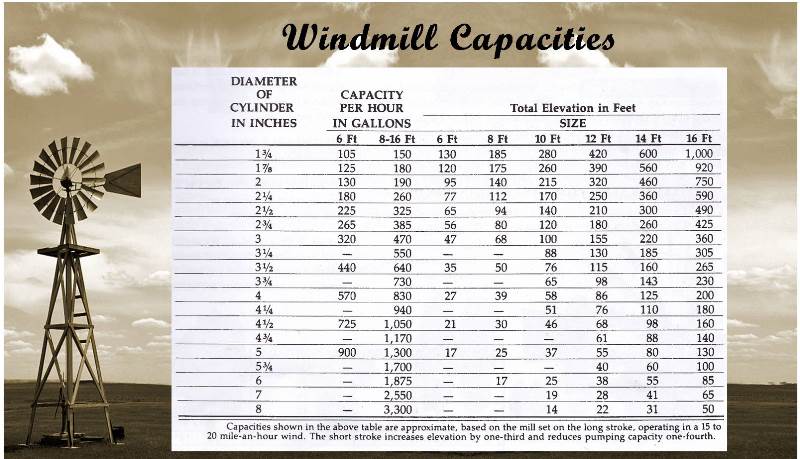 The charts established for the windmill industry – capacity, depth, size of cylinder and size of windmill are pictured left.
The charts established for the windmill industry – capacity, depth, size of cylinder and size of windmill are pictured left.
Our current model has a 16” stroke, operates a 4” windmill pump cylinder, and is set over a well with and 80’ static water level, 2” drop pipe, 3/4” sucker rod, yielding 0.87 gallons per stroke. One young man yielded 22 gallons in one minute on his first attempt and a grandmother easily pumped 7 gpm.
According to the flow rate chart, at peak performance a 12′ windmill can pump 13.8 gallons in one minute with a 4” cylinder with 80 feet of head. These flow rates are ideal conditions. With the WaterBuck Pump, just ONE young man easily exceeded the theoretical flow rate of a 12’ windmill by nearly 60 percent.
Which is the right hand pump for a community?
WaterBuck vs. Traditional Community Hand Pumps
Application: a shallow well with a 20’ static water level under average operation.
Traditional Hand Pump Yield: 3 gpm, 180 gallons an hour x 12 hours = 2,160 gallons.
Dual WaterBuck Pump Yield: 94 gpm, 5640 gallons an hour x 12 hours = 67,680 gallons
Would you like to know how much water you can get from your water well with the WaterBuck Pump? Please check out the performance chart.
“WaterBuck Pump Pricing and Quote”
Video Demonstration
Here is a video demonstration of our pump model yielding 22 gpm.
Other videos of operators of different age groups can be viewed here. WaterBuck Videos
This is one incredible human-powered water pump. Please share with your friends.
.
Our products offer a much better quality of life for the self-reliant
© 2014-2015 Well WaterBoy Products LLC ♦ WaterBuck Pump™ (patent pending) ♦ Pedal Powered PTO™
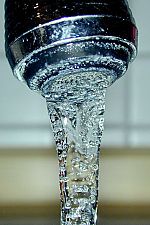
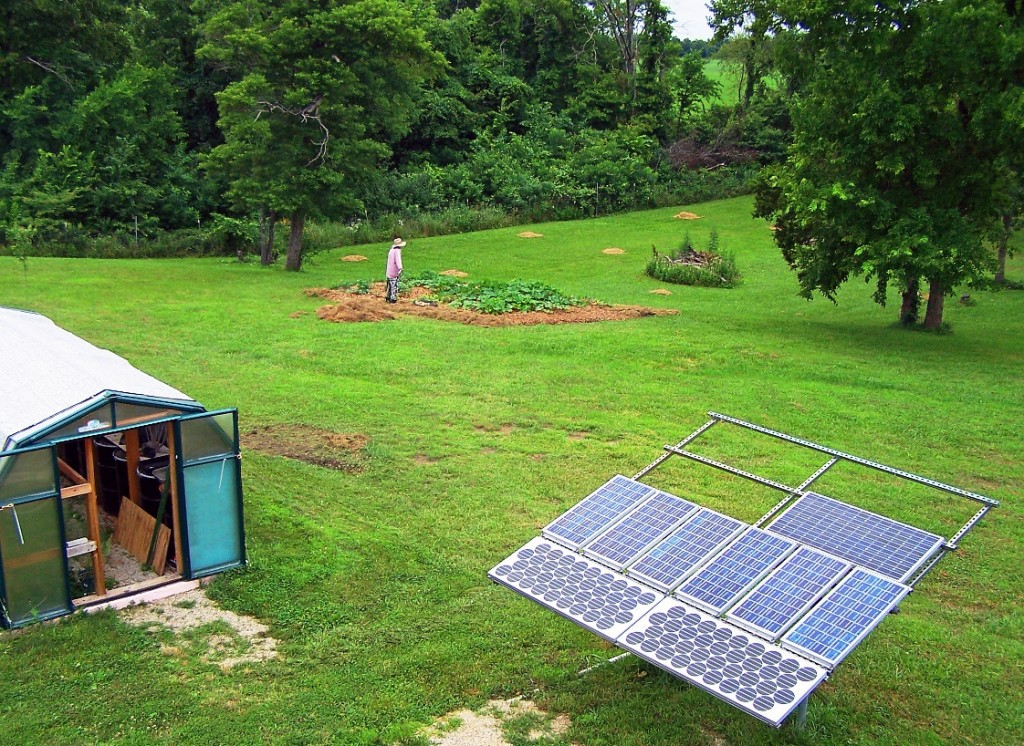

A very insightful article about the future and how to prepare for it. Pump technology has evolved significantly in the past few years and there are all sorts of ingenious designs on the market. Thanks for the great post.
Pingback: WaterBuck Pump Performance Chart | Well WaterBoy Products